
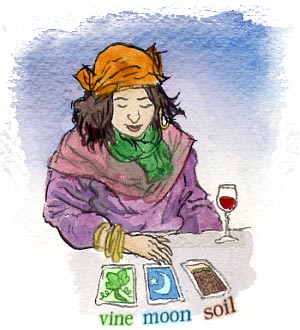
The Tarot of Terroir: Practicing Sensitive Crystallization in Paso Robles
Sensitive Crystallization: The theory is that if you combine copper chloride with any matter from a vineyard site -- soil solution, macerated leaves, grape must, or finished wine -- a particular site should have a crystal structure different from that of other sites.
by
Mary Baker
May 16, 2006
Some species of bamboo flower only once every one hundred years. A single bamboo seedling, wherever grown in the world, will flower at the same time as its parent.
According to an examination of United States Coast and Geodetic Survey Tidal Data, the lowest tides in deep ocean ports occur precisely under each full and new moon, a phenomenon now understood as the effect of the moon’s gravitational pull.
In the study of tarot, numbers have a resonance, a vibration -- a concept at odds with Western education which teaches us that numbers are inert abstractions that we control. We take, add, divide, construct. For many of us, this language-logic permeates all of our instruction in math, and affects all of our logic and perceptions. The mathematical purity of an arch is somehow our birthright and we do not question its existence, or acknowledge that numbers are merely a language for exploring dimensions within and beyond our world that already exist in purity and balance. But if we continue to think in terms of the language-logic we learn in school, there is no room in our logic for the magic of the Kabbalah, tarot, gnothology and many other wild and wonderful things that are deemed occult because they are not explained by our Western language-logic.
At a recent terroir conference held at U.C. Davis, Randall Grahm presented an intriguing experiment with ‘sensitive crystallization’. The theory is that if you combine copper chloride with any matter from a vineyard site -- soil solution, macerated leaves, grape must, or finished wine -- a particular site should have a crystal structure different from that of other sites. Grahm showed slides of a 2002 Van Voxem Riesling from the Saar, featuring a symmetrical starburst with deep ridges "indicating a strong presence of organizing forces in the wine.”
A 2005 Bonny Doon Riesling from Soledad had three intertwined ‘nexi’ indicating "strong life forces in the vineyard" but a need for "a greater degree of organization once the vines and soil become better acquainted.”
The concept of identity-specific crystallizations is explained in Sensitive Crystallization Processes, written by Dr. Ehrenfried Pfeiffer (published by Steiner Books Anthroposophic Press). Pfeiffer is a student of Rudolf Steiner, who is in turn regarded as the father of organic and biodynamic farming. According to Dr. Pfeiffer, “any part taken from the whole will have, when properly prepared, the same crystallization pattern as any other part.”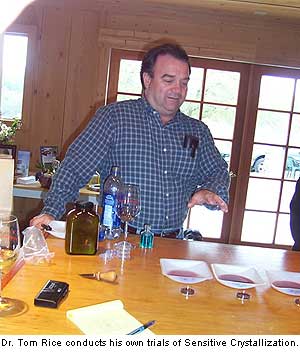
Part of Dr. Pfeiffer’s theory is that each species has its own distinctive pattern, and that one can learn to discern imbalances by comparing crystallization plates of healthy subjects to those of unhealthy ones. It has also been suggested that a plant grown at a specific site would have a characteristic pattern that differs from other sites. So theoretically, a crystallization sample of a finished wine might be identical to its grape must, or even a solution of macerated leaves from the source vineyard, becoming in essence a stamp of the wine’s terroir and the viticultural effects superimposed upon it by man.
Dr. Tom Rice, professor of soil science at California Polytechnic Institute, and I decided to adventure into this misty anthroposophical realm ourselves. As we studied the transcript of Grahm’s presentation, it occurred to us that Dr. Rice could easily procure copper chloride and petri dishes, and I could supply samples of vineyard designated wines. Why not?
With the illicit glee of teenagers planning a séance, we agreed to meet and try it out for ourselves. I should stress, before continuing, that we did this for fun and out of curiosity.
To test the theory, we prepared four pairs of petri dishes from four unique sites:
Hansen Vineyard 2003 Cabernet
Hansen Vineyard 2004 Viognier
Alto Pomar 2003 (vineyard specific Rhone blend)
Alto Pomar 2002 (vineyard specific Rhone blend)
Starr Ranch 2004 Roussanne
Starr Ranch 2004 Syrah
Dove Pond 2001 Zinfandel Port
Dove Pond 2002 Syrah
Lacking any clear guidance as to ratios, we used copper chloride in a 1:1 solution. Then we mixed 2 parts of copper chloride solution to 3 parts of wine. Each petri was swirled clockwise 10 times, and counter-clockwise once. The petris were placed in a reasonably controlled environment, and the crystals took approximately four days to form.
Immediately upon adding the solution to the 2003 Alto Pomar, the pigment curdled. This doesn’t look good, I thought. Alto Pomar is a tiny, organic vineyard in southeast Paso Robles on the high orchard benches above Atascadero. Owner Dennis Sharpe produces small lots of Grenache, Syrah, and Mourvèdre. In studying the resulting Alto Pomar crystals, they are significantly different from the other three vineyards, as they showcased much more green pigment and a raised texture.
Here are the crystallizations that our petris produced:
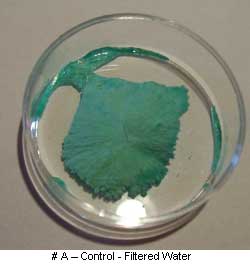
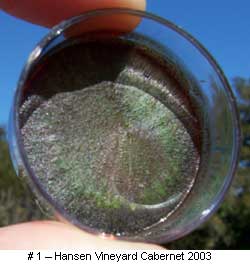
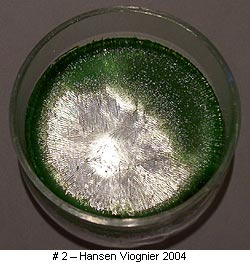
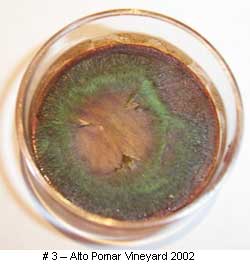
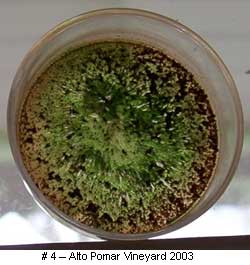
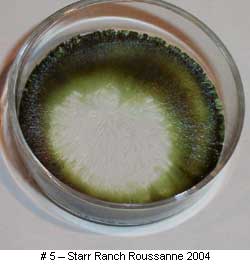
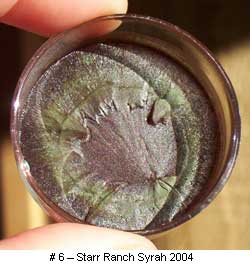
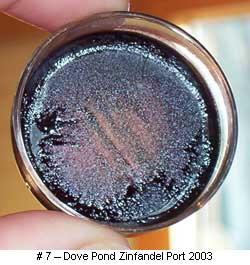
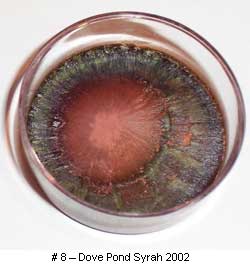 I am guessing that since the purified water crystals gathered in the center like a bouquet, water from the wine samples would act in a similar manner, and that other, perhaps heavier components in the wine would move to the perimeter.
I am guessing that since the purified water crystals gathered in the center like a bouquet, water from the wine samples would act in a similar manner, and that other, perhaps heavier components in the wine would move to the perimeter.
When viewed as pairs, the two Alto Pomar samples were distinctly different from the othe
According to an examination of United States Coast and Geodetic Survey Tidal Data, the lowest tides in deep ocean ports occur precisely under each full and new moon, a phenomenon now understood as the effect of the moon’s gravitational pull.
In the study of tarot, numbers have a resonance, a vibration -- a concept at odds with Western education which teaches us that numbers are inert abstractions that we control. We take, add, divide, construct. For many of us, this language-logic permeates all of our instruction in math, and affects all of our logic and perceptions. The mathematical purity of an arch is somehow our birthright and we do not question its existence, or acknowledge that numbers are merely a language for exploring dimensions within and beyond our world that already exist in purity and balance. But if we continue to think in terms of the language-logic we learn in school, there is no room in our logic for the magic of the Kabbalah, tarot, gnothology and many other wild and wonderful things that are deemed occult because they are not explained by our Western language-logic.
At a recent terroir conference held at U.C. Davis, Randall Grahm presented an intriguing experiment with ‘sensitive crystallization’. The theory is that if you combine copper chloride with any matter from a vineyard site -- soil solution, macerated leaves, grape must, or finished wine -- a particular site should have a crystal structure different from that of other sites. Grahm showed slides of a 2002 Van Voxem Riesling from the Saar, featuring a symmetrical starburst with deep ridges "indicating a strong presence of organizing forces in the wine.”
A 2005 Bonny Doon Riesling from Soledad had three intertwined ‘nexi’ indicating "strong life forces in the vineyard" but a need for "a greater degree of organization once the vines and soil become better acquainted.”
The concept of identity-specific crystallizations is explained in Sensitive Crystallization Processes, written by Dr. Ehrenfried Pfeiffer (published by Steiner Books Anthroposophic Press). Pfeiffer is a student of Rudolf Steiner, who is in turn regarded as the father of organic and biodynamic farming. According to Dr. Pfeiffer, “any part taken from the whole will have, when properly prepared, the same crystallization pattern as any other part.”

Part of Dr. Pfeiffer’s theory is that each species has its own distinctive pattern, and that one can learn to discern imbalances by comparing crystallization plates of healthy subjects to those of unhealthy ones. It has also been suggested that a plant grown at a specific site would have a characteristic pattern that differs from other sites. So theoretically, a crystallization sample of a finished wine might be identical to its grape must, or even a solution of macerated leaves from the source vineyard, becoming in essence a stamp of the wine’s terroir and the viticultural effects superimposed upon it by man.
Dr. Tom Rice, professor of soil science at California Polytechnic Institute, and I decided to adventure into this misty anthroposophical realm ourselves. As we studied the transcript of Grahm’s presentation, it occurred to us that Dr. Rice could easily procure copper chloride and petri dishes, and I could supply samples of vineyard designated wines. Why not?
With the illicit glee of teenagers planning a séance, we agreed to meet and try it out for ourselves. I should stress, before continuing, that we did this for fun and out of curiosity.
To test the theory, we prepared four pairs of petri dishes from four unique sites:
Lacking any clear guidance as to ratios, we used copper chloride in a 1:1 solution. Then we mixed 2 parts of copper chloride solution to 3 parts of wine. Each petri was swirled clockwise 10 times, and counter-clockwise once. The petris were placed in a reasonably controlled environment, and the crystals took approximately four days to form.
Immediately upon adding the solution to the 2003 Alto Pomar, the pigment curdled. This doesn’t look good, I thought. Alto Pomar is a tiny, organic vineyard in southeast Paso Robles on the high orchard benches above Atascadero. Owner Dennis Sharpe produces small lots of Grenache, Syrah, and Mourvèdre. In studying the resulting Alto Pomar crystals, they are significantly different from the other three vineyards, as they showcased much more green pigment and a raised texture.
Here are the crystallizations that our petris produced:








 I am guessing that since the purified water crystals gathered in the center like a bouquet, water from the wine samples would act in a similar manner, and that other, perhaps heavier components in the wine would move to the perimeter.
I am guessing that since the purified water crystals gathered in the center like a bouquet, water from the wine samples would act in a similar manner, and that other, perhaps heavier components in the wine would move to the perimeter. When viewed as pairs, the two Alto Pomar samples were distinctly different from the othe













